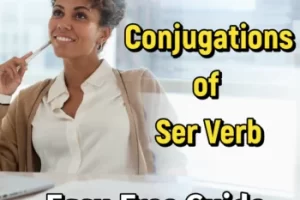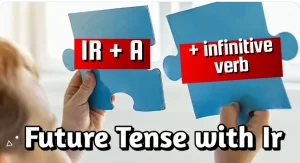
Spanish Future Tense Conjugations
- Posted by Delilah
- Categories Uncategorized
- Date September 7, 2024
- Comments 9 comments
Future Tense Conjugations in Spanish
Spanish in Atlanta will cover Spanish future ( compound future), go over the Spanish future conjugations and formula needed to create sentences in future tense! Use Spanish in Atlanta’s FREE Spanish future tense conjugations worksheet for practice; we will also offer premium worksheets for students that want more Spanish future conjugations practice! Our Spanish online store will offer all printable Spanish practice worksheets! We post new content every 4 weeks!
Spanish Future Tenses:
There are 2 future “tenses” The simple future and the compound future tense! We will focus on the compound future tense because it is the most used by Spanish native speakers. If you want us to create an additional blog post on the simple future, comment below!
Spanish Future Conjugations & Formula:
The compound future tense is created by using the IR VERB + A + Any infinitive verb. Spanish speakers use this form of future “tense” the most! It makes common sense to focus on mastering this one first.
IR Verb in Spanish:
YO VOY NOSOTROS VAMOS
TÙ VAS ELLOS VAN
ÈL VA ELLAS VAN
ELLA VA USTEDES VAN
USTED VA
You must use the Ir verb conjugations above to create this popular form of Spanish future tense! Listen to the Ir verb in Spanish audio file below for pronunciation help! Want professional help with interaction & engaging Spanish exercises? Join one of our Spanish 3 classes live online- get details here.
Ir Verb in Spanish Conjugations Audio File
Compound Future Examples:
- VOY A COMER
- VOY A ESTUDIAR
- VOY A TRABAJAR
- VOY A ESTAR
- VOY A ESCUCHAR
- VOY A CAMINAR
- VOY A BAILAR
The examples above show the Yo conjugations of the Ir verb in Spanish + A + infinitive verb. You will NEVER conjugate the second verb. These is how you tell Spanish speakers what your future plans are. By saying ” VOY A COMER” you are telling people that COMER is planned sometime in the future. “VOY A” just alerts people that COMER will happen in the future!
Future Tense Practice Exercises Vid:
How to Practice the Spanish Future:

- Practice telling yourself what your plans are in the future- record yourself with your smartphone!
- Practice creating & saying the future sentences out loud!
- Use our FREE Spanish future tense practice worksheet!
- Do the video above!
- Create a Spanish “diary” write in it.
- Talk to yourself in the car; create 10 sentences a day!
- Take our Spanish 3 class & get professional help!

Want to learn Spanish with Us?
Take one of our 6 week Spanish courses LIVE via zoom. We offer a free mini demo, assessment & Spanish placement test. Talk to our professional Spanish instructor 1 on 1 and get the answers you need before signing up! Spanish in Atlanta’s Spanish classes, lessons and tutoring are the highest rated Spanish language classes in Atlanta GA, Houston & all of the USA!
Your instructor Dee. Ortiz is a native speaker of Spanish & English and able to also speak Italian & French. Dee has 33 years of experience teaching foreign languages. Class environment will be interactive, supportive, fun & professional!
You may also like

Ser Verb Conjugations

Beginner Stories in Spanish




9 Comments
Gracias! This guide has helped me! I had been using the other Spanish future tense more since it’s what I learned in school.
This is practical and easy. I am so glad I found your website. Is there a difference between this spanish future tense and the simple future?
Thank you! I can’t wait to read your future content! Everything I have read thus far has been great. 🙂
It seems that schools and colleges always teach you text book Spanish and not real people Spanish. I have heard this Spanish future used more with my friends.
Spanish past tense is the hardest for me. This Spanish future tense is not bad. I like the explanation and thanks for the free Spanish future tense worksheet. I have followed the instructions and reading it out loud has helped. I didn’t think it would. Mucho gracias senora
I’ve been exploring the various tenses in Spanish, and I’m curious about the simple future tense. Can you explain what the endings are for the different verb conjugations? I’ve seen the future tense referred to in a few different ways, and I’m a bit confused about what the “real” Spanish future tense is. Is it just the simple future, or are there other forms I should be aware of? Can the Real Slim Shaddy please stand up? LOL
Hola Tim,
El Real Slim Shaddy es the compound future jajajajaja. Real Spanish speakers use this “future tense” instead of the simple future. The Spanish simple future tense is practically the same thing. The simple future tense uses endings:
É
ÁS
Á
EMOS
ÁN
You put these endings at the end of all infinitive verbs. The difference between the compound future tense and the simple future is similar to saying:
I AM GOING TO STUDY SPANISH VS I WILL STUDY SPANISH
My best advice for beginner Spanish students is use the Spanish future tense discussed in this blog post- so use the compound future.
I’ve noticed that a lot of Spanish schools and textbooks mainly focus on teaching the simple future tense while ignoring other future tenses. It feels like there’s so much more to the Spanish language that gets overlooked. This can make it challenging to fully understand how to express future actions in Spanish. I’m glad I read the other comments. I am going to stick to the compound future tense!
Hola Robert,
I hate that! it’s true a lot of Spanish schools, universities, Spanish text books etc… seem to focus on the very things that real Spanish speakers don’t use in daily Spanish conversations.
People in real life use the compound future a lot more than the simple future.
That’s why it’s best to learn with a native Spanish speaker because you will get insights that only Spanish speakers will have compared to non native speakers and generic Spanish learning apps, books etc…
You can use Spanish apps, books etc… if you like but make sure you also have an authentic Spanish resource you can use to check what is considered real Spanish vs text book Spanish.